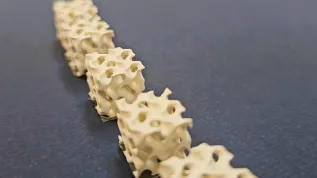
Terahertz radiation can be used to detect concealed weapons and image changes in the deeper layers of the skin. Polish-French group of physicists has developed a new source of such radiation, which may prove to be a breakthrough in the application of this method.
Terahertz radiation (order of 10 ^ 12 Hz), also known as electromagnetic radiation in the far infrared range, is suppressed in electrically conductive substances such as metals, and in water and electrolytes, and very poorly suppressed in so-called dielectrics, e.g. fats, plastics, dentin, bone, paper, clothes - according to the Institute of Physics PAS in Warsaw release sent to PAP.
Terahertz radiation is also safe for living organisms. It can therefore be used, for example, in dermatology for non-invasive imaging of changes in the deeper layers of the human skin (such as burns and suspected lesions), and in dentistry, replacing radioscopy that affects health. Terahertz radiation is also used for quality control of packaged foods, to detect weapons hidden under clothing, and in chemical analysis of sealed envelopes.
As explained in the release, the main problem in the wader application of methods based on terahertz radiation have been difficulties in obtaining adequate sources of radiation and inexpensive, sensitive detectors. Meanwhile, a group of researchers from the Institute of Physics PAS together with two groups of scientists from Paris (Laboratoire Pierre Aigrain, Ecole Normale Supérieure and the Institut des Nanosciences de Paris) have developed a new, adjustable semiconductor terahertz radiation source.
Their results have been published in the prestigious journal "Physical Review Letters". Physicists expect that this could be a milestone on the road to wide applications of terahertz radiation.
Authors have shown that "modulating doped quantum wells made of diluted magnetic semiconductors" can be an effective sources of far infrared electromagnetic radiation. The advantage of the solution is that the energy of the emitted radiation can be adjusted.
Researchers from the Institute of Physics PAS not only participated in the development of terahertz radiation sources, but also studied the methods of detection of such radiation. "Both of these discoveries pave the way to potential applications of such nanostructures of diluted magnetic semiconductors in the terahertz area, particularly in biology and medicine" - commented the Institute representatives.
Research at the Institute of Physics PAS was partly financed the project "Quantum semiconductor nanostructures for applications in biology and medicine" under the Operational Programme Innovative Economy. (PAP)
lt/ agt/ mrt/
tr. RL













